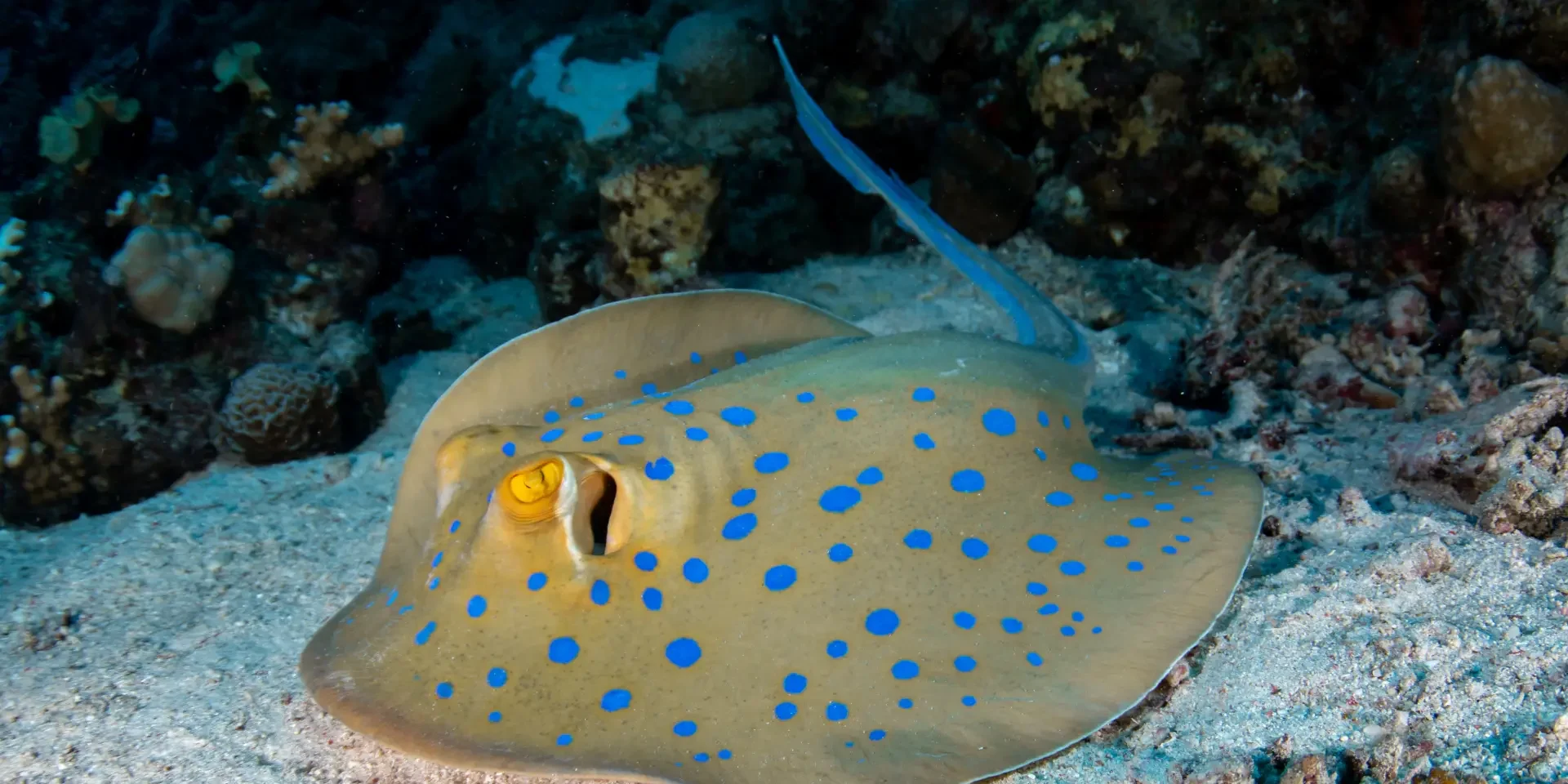The Blue-Spotted Stingray: Hurghada’s Graceful Reef Glider
There’s something undeniably magical about the moment a blue-spotted stingray glides effortlessly across the sandy bottom beneath you. With its brilliant neon-blue spots and smooth, undulating motion, this elegant marine creature is a favorite among divers in Hurghada—and for good reason.
In the Red Sea’s clear, warm waters, the blue-spotted stingray is a common yet always thrilling sight. Whether you’re an experienced diver or exploring the underwater world for the first time, learning more about this stingray enhances every encounter.
At scubadore hurghada, we regularly visit dive sites where blue-spotted stingrays are known to make appearances. Read on to learn more about their behavior, appearance, habitat, and how you can spot one during your next dive.
Meet the Blue-Spotted Stingray
The blue-spotted stingray (Taeniura lymma), also known as the blue-spotted ribbontail ray, is one of the most recognizable species of ray in the Red Sea. It belongs to the family Dasyatidae and is admired for its vibrant appearance and graceful movement.
Key Characteristics:
-
Body Shape: Rounded, disk-like body with a short, thick tail
-
Coloration: Golden-brown to olive body with vivid electric-blue spots and blue side stripes on the tail
-
Size: Up to 70 cm across, with a tail extending up to twice the body length
-
Tail Spines: Two venomous spines used for defense
-
Lifespan: Approximately 13–25 years in the wild
Despite their somewhat intimidating tail spines, these rays are not aggressive. They’re shy by nature and will often flee when approached. Most injuries associated with stingrays occur when they’re accidentally stepped on—one of many reasons divers are trained to practice good buoyancy and awareness.
Behavior and Daily Life
Blue-spotted stingrays are typically solitary, although small groups are sometimes observed resting together. They prefer sandy lagoons and shallow reef areas, where they can hide easily from predators and rest during the day.
Daily Activity:
-
Nocturnal Feeders: Active mostly at night, they use electroreception and their keen sense of smell to locate prey buried in the sand.
-
Diet: Crustaceans, mollusks, worms, and small fish
-
Resting Habits: During daylight hours, they often lie motionless on the seafloor, partially buried beneath a thin layer of sand, with just their eyes and spiracles (breathing holes) visible.
Divers who move slowly and stay low may be rewarded with a glimpse of this ray taking off in a slow, elegant flutter across the reef—an unforgettable sight.
Where to See Blue-Spotted Stingrays in Hurghada
Although stingray sightings can never be guaranteed, certain sites around Hurghada offer excellent chances for encounters—especially those with sandy bottoms, coral ledges, and gentle slopes.
Top Dive Sites for Sightings:
Sachwa Abu Galawa
This site is well known for winter stingray sightings. The sandy areas between coral outcrops are ideal for rays to rest and hide.
Marsa Abu Galawa
Divers often spot stingrays near the mooring line or tucked beside coral bommies. Batfish are also common here, adding to the site’s variety.
Fanadir South
Offers a mix of reef and sand habitats. Look carefully along the base of coral heads or under shallow ledges.
Sabrina
A shallow, easy dive ideal for beginners and those looking to spend more time near the bottom where rays often glide by or rest.
At scubadore hurghada, we select daily dive sites based on conditions and guest preferences, but our guides always keep an eye out for these elegant animals and know the hotspots to check.
Tips for Spotting and Photographing Them
Blue-spotted stingrays are photogenic, but their shyness and quick reflexes make them challenging subjects. Here’s how to increase your chances of a good sighting—and a great shot:
1. Perfect Your Buoyancy
Avoid stirring up sediment, which can scare rays off or cloud your view. Staying neutrally buoyant just above the bottom allows you to approach without disruption.
2. Look Carefully
They’re often buried in the sand with only their eyes and spiracles showing. Scan for movement or subtle color changes in the substrate.
3. Move Slowly
Quick movements will send them fluttering away. Glide along calmly, pausing when you think you see something unusual.
4. Lighting Matters
Natural sunlight often highlights their spots beautifully. If using a strobe or torch, keep it at an angle to reduce backscatter.
5. Respect Their Space
Never try to touch or chase a stingray. Their tail spines are purely defensive, but they will use them if they feel threatened.
A Vital Part of the Ecosystem
Beyond their beauty, blue-spotted stingrays play a key ecological role on the reef. As bottom feeders, they help control populations of small invertebrates, turning over sediment and maintaining balance in the benthic ecosystem.
Their predators include larger sharks, dolphins, and some large groupers. Their only real defense is camouflage, speed, and their venomous tail barbs—which serve more as a last resort than a hunting tool.
A Responsible Approach to Marine Life
At scubadore hurghada, we’re passionate about protecting the marine life we’re so lucky to dive with every day. Our guides educate divers on proper underwater behavior to ensure we’re respectful guests in the reef’s natural habitat.
We encourage all divers to:
-
Maintain proper buoyancy and control
-
Avoid touching or disturbing marine animals
-
Use reef-safe sunscreen and eco-conscious gear
-
Leave only bubbles—take only pictures and memories
By diving responsibly, we ensure that species like the blue-spotted stingray continue to thrive for generations to come.
Dive with Us and See for Yourself
Every dive in Hurghada offers the chance for something amazing—but seeing a blue-spotted stingray glide across the reef floor is a moment that stays with you. Whether you’re brand new to diving or a seasoned enthusiast, our team at scubadore hurghada knows exactly where and how to find the Red Sea’s hidden gems.
Join us for a dive adventure, and maybe—just maybe—you’ll witness the graceful flight of Hurghada’s most dazzling glider.







